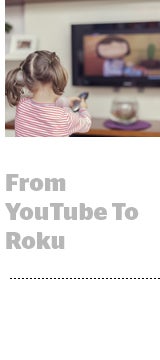Popular YouTube channels for kids are migrating to the TV set through The Roku Channel and other ad-supported apps.
Launched in 2017, The Roku Channel aggregates free content distributed on Roku’s platform along with live TV networks, premium video subscriptions and content packages geared toward different genres and age groups.
When The Roku Channel launched a section for kids and families in late 2019, it began including content from YouTube creators with large audiences.
Ryan’s World, a popular children’s YouTube channel that joined The Roku Channel last August, for example, has 25 million YouTube subscribers. Cocomelon, the No. 1 YouTube channel globally for hours viewed, with a subscriber base 85 million strong, launched on The Roku Channel in May. Kids Diana Show, which also launched on the platform in May, has 123 million YouTube subscribers.
As these creators look to build their massive audiences beyond YouTube, streaming TV is a natural place to grow, said Rob Holmes, VP of programming at Roku.
“Content creators use the YouTube platform as a way of publishing,” he said. “They need something like The Roku Channel to transition into streaming.”
Pocket.watch, the entertainment company that represents Ryan’s World and Kids Diana Show, among other YouTube creators, began working with The Roku Channel in 2019 and has seen up to 40% growth in viewership on the platform since. The company helps YouTubers diversify their brands into TV, retail, ecommerce and mobile gaming.
“YouTube is a great place to understand and build audiences,” said David Williams, SVP and GM of channels at pocket.watch. “But so much of the opportunity happens off of YouTube.”
Most creators start by distributing content they’ve already posted to YouTube to The Roku Channel, which topped 56 million viewers in 2019. Roku helps launch and promote the shows.
“Launching a streaming app, finding the audience and marketing it is too hard,” Holmes said. “Because of the network effects of the platform we built, these folks can move over to streaming.”
As viewership grows, some creators adapt their content into longer episodes. Ryan’s World, for example, launched the fourth season of its scripted show “Ryan’s World Specials” on The Roku Channel in April. The episodes run 22 minutes long and seasons follow an overarching storyline.
Like other content providers on Roku, YouTube creators make money through advertising rev-share deals with the platform. Roku handles the ad sales and gives creators a cut, which it declined to disclose. But CTV is a premium environment, and Roku sets high standards, only working with top creators with dedicated and sizable audiences, Holmes added.
Roku is expanding its work with YouTube creators in the kids and family genre, as children have a higher affinity for creator-driven content. “Kids and parents view them as brands that are of equal prominence with brands on TV these days,” Holmes said.
But Roku is not the only streaming platform building relationships with YouTube talent. Pocket.watch clients also distribute on Hulu, Amazon Prime Video, Samsung TV Plus, Xumo and Pluto TV. Hulu was one of the first streaming providers to get involved with pocket.watch’s creators, licensing 90 episodes of content in 2018 and doubling that to 180 in 2019, Williams said.
Since YouTube is hands-off with creators, it’s relatively easy for YouTubers to take their IP to other places. But that will be an interesting dynamic to watch as YouTube moves deeper into CTV.
“They’re making a big investment in the kid’s space,” Williams said. “They are commissioning original programming. They’re still the 800-pound gorilla when it comes to kids’ viewership.”
















